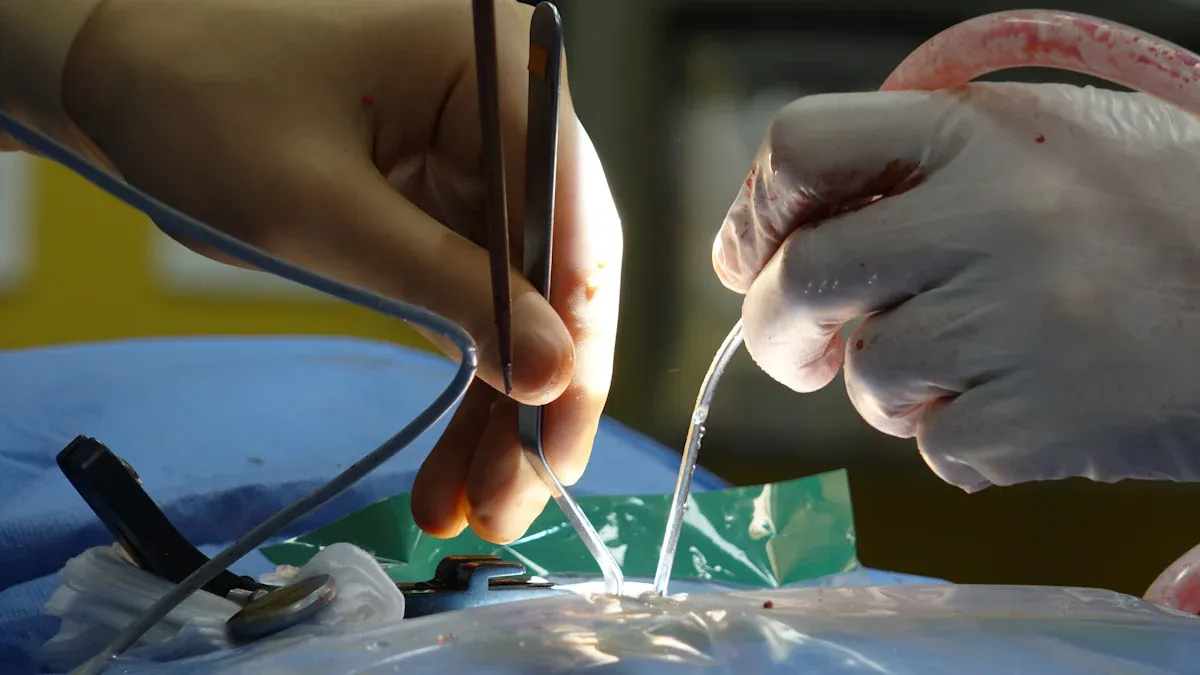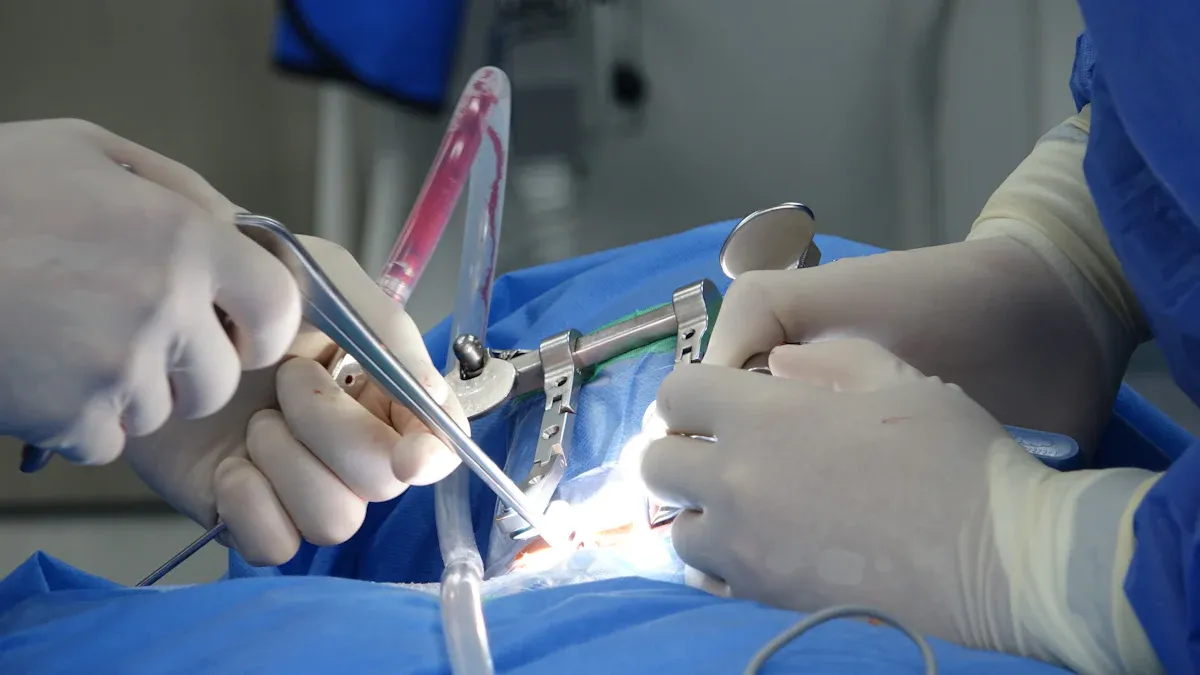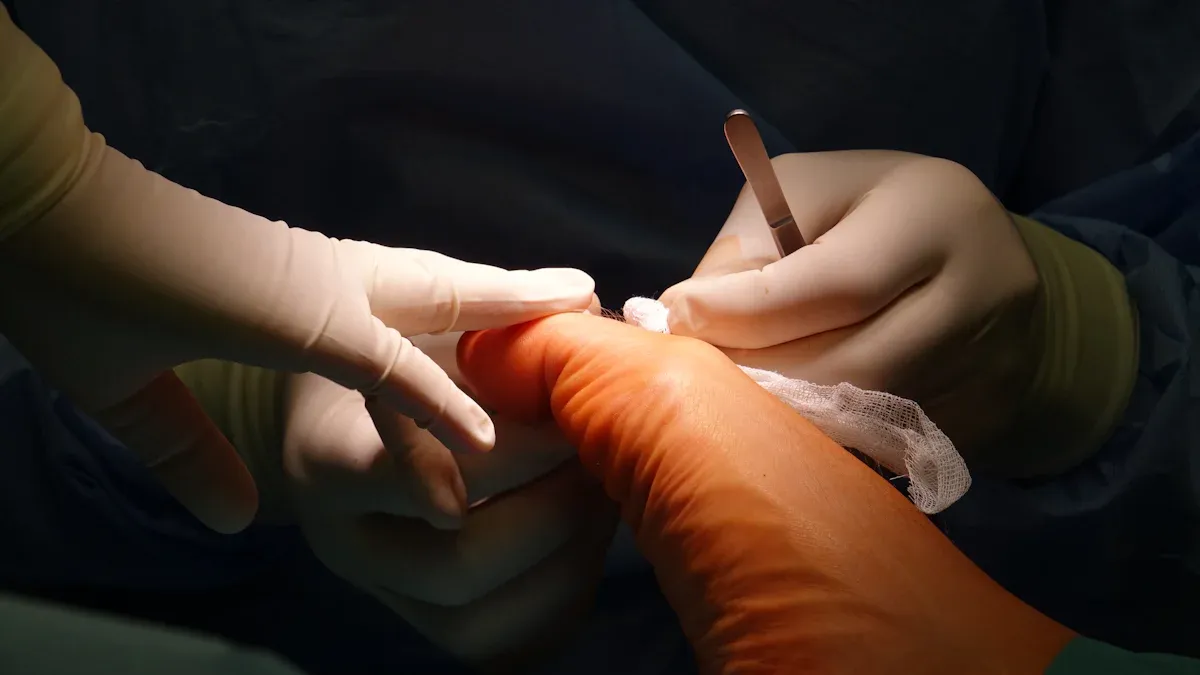Choosing the Right Nitinol Guidewire for Precision in Neurosurgery

Selecting the right customizable nitinol guidewire for neurosurgery plays a pivotal role in ensuring precision and safety during advanced neurosurgery procedures. These guidewires offer exceptional control and adaptability, making them indispensable tools in minimally invasive surgery. Their ability to navigate complex anatomy reduces risks and enhances surgical outcomes. Key factors such as material properties, dimensional accuracy, and performance characteristics determine the suitability of a guidewire. By prioritizing these aspects, surgeons can achieve optimal results while maintaining patient safety and procedural efficiency. Choosing the correct guidewire is essential for the success of any neurosurgical operation.
Key Takeaways
Nitinol guidewires are very flexible and can return to their shape. This helps them move safely through tricky brain blood vessels.
Nitinol is safe for the body and doesn’t irritate tissues. It lowers the chance of infections during surgery, keeping patients safer.
Picking the right size and length of the guidewire is important. It helps doctors move it accurately and avoid problems in surgery.
These guidewires are made with great care, so they work well. They give doctors better control and slide smoothly during operations.
Guidewires can be customized with special sizes or coatings. This makes them work better for different types of surgeries.
Material Properties of a Customizable Nitinol Guidewire for Neurosurgery

Superelasticity and Shape Memory
Nitinol's superelasticity and shape memory properties make it an ideal material for neurosurgical guidewires. Superelasticity allows the guidewire to bend and conform to the intricate pathways of the neurovascular system without losing its structural integrity. This flexibility ensures that surgeons can navigate delicate and complex brain anatomy with minimal risk of damage to surrounding tissues. Shape memory further enhances the guidewire's functionality by enabling it to return to its original form after deformation. This characteristic is particularly valuable during stent deployment, as it minimizes complications and ensures precise placement.
A study on nitinol tubing for neurovascular stents highlights the importance of these properties. Superelasticity enables stents to adapt to the unique shapes of blood vessels, while shape memory ensures they maintain their intended form after deployment. These features collectively reduce the risk of vessel damage and improve procedural outcomes.
Biocompatibility and Patient Safety
Biocompatibility is a critical factor in the design of nitinol guidewires. The smooth surface of nitinol tubing for neurovascular stents minimizes the risk of tissue irritation and infection, ensuring patient safety during and after surgery. This property is essential for reducing immune responses and promoting healing in sensitive neurovascular environments.
Research on nitinol guidewires, such as the uFINE-Is, demonstrates their excellent biocompatibility. Within 28 days of implantation, significant endothelialization occurs, which is crucial for integrating the guidewire into the body. By three months, further development is observed, with no signs of inflammation or necrosis. These findings underscore the safety profile of nitinol guidewires, making them a reliable choice for neurosurgery.
Durability and Corrosion Resistance
Durability and corrosion resistance are vital for the long-term performance of nitinol guidewires. The neurovascular system subjects guidewires to constant pressure and movement, requiring materials that can withstand fatigue without failure. Nitinol tubing for neurovascular stents excels in this regard, offering exceptional fatigue resistance that ensures consistent performance throughout the procedure.
Corrosion resistance further enhances the reliability of nitinol guidewires. Exposure to bodily fluids can degrade less robust materials, but nitinol's unique composition prevents corrosion, maintaining its structural integrity over time. This durability reduces the likelihood of complications and ensures that the guidewire performs optimally in demanding surgical environments.
A comparative analysis of material properties highlights nitinol's superiority in durability and corrosion resistance. These attributes, combined with its flexibility and adaptability, make it the preferred choice for neurosurgical applications.
Dimensional Specifications for Neurosurgical Guidewires
Diameter and Length Considerations
The diameter and length of a guidewire play a crucial role in its performance during neurosurgery. A guidewire must be thin enough to navigate the intricate pathways of the neurovascular system while maintaining sufficient strength to avoid deformation. Common diameters range from 0.014 inches to 0.038 inches, depending on the specific procedure. Length is equally important, as it must accommodate the anatomical region being treated. For example, longer guidewires are often required for procedures involving deeper or more complex pathways. Selecting the appropriate dimensions ensures precise navigation and reduces the risk of complications.
Tolerances for Precision
Precision in neurosurgery depends heavily on the tolerances of the guidewire. Tolerances refer to the allowable variations in the guidewire's dimensions, which directly impact its performance. High-precision manufacturing processes ensure that tolerances remain within strict limits. For instance, measurement accuracy of ±0.001 mm and coating thickness tolerances of 10 microns ± 2 microns are standard in high-quality nitinol guidewires. These specifications minimize friction and enhance control during procedures.
Measurement Type | Value |
|---|---|
CPK Values | Over 1.7 |
Measurement Accuracy | ±0.001 mm (±0.000040 in.) |
Coating Thickness Tolerance | 10 microns ± 2 microns |
Total Tolerance on 22-ft Guidewire | 4 microns |
Friction Test Method | ASTM D-1984 |
Coated Wires Produced Daily | More than 20,000 |
Such stringent tolerances ensure that the guidewire performs reliably, even in the most demanding surgical environments.
Compatibility with Surgical Instruments
A guidewire must seamlessly integrate with other surgical instruments to ensure procedural success. Compatibility with catheters, stents, and other devices is essential for smooth operation. Nitinol guidewires are designed to work with a wide range of instruments, thanks to their flexibility and precise dimensions. This compatibility reduces the risk of instrument failure and enhances the surgeon's ability to perform complex maneuvers. Selecting a guidewire that aligns with the surgical tools used in neurosurgery ensures a cohesive and efficient workflow.
Performance Requirements for Neurosurgical Guidewires
Flexibility and Kink Resistance
Flexibility and kink resistance are essential attributes for neurosurgical guidewires. These features allow the guidewire to navigate the intricate and delicate neurovascular pathways without compromising its structural integrity. Neurosurgeons rely on guidewires that can bend and adapt to complex anatomical curves while maintaining smooth operation.
Recent advancements in micro-guidewire technology have significantly improved flexibility and trackability, making them ideal for minimally invasive surgery. The rising incidence of neurological disorders, such as aneurysms and strokes, has further emphasized the need for guidewires with superior kink resistance. A growing preference for minimally invasive procedures highlights the importance of these performance characteristics.
Evidence Type | Description |
|---|---|
Guidewire Role | Guidewires are crucial for neurovascular interventions, including treatment of aneurysms and stroke. |
Increasing Incidence | Rising incidence of neurological disorders necessitates advanced guidewire technology. |
Minimally Invasive Preference | Growing preference for minimally invasive procedures highlights the need for flexible and kink-resistant guidewires. |
Technological Advancements | Development of micro-guidewires with improved flexibility and trackability enhances application in complex neurovascular pathways. |
Stress Resistance and Fatigue Life
Stress resistance and fatigue life are critical factors that determine the reliability of nitinol guidewires during surgery. These guidewires endure repeated loading and movement within the neurovascular system, requiring materials that can withstand millions of stress cycles without failure. Nitinol's unique properties, including its high strength-to-weight ratio and superelasticity, make it an excellent choice for such demanding applications.
Manufacturing processes and material purity play a significant role in enhancing fatigue resistance. By optimizing these factors, nitinol guidewires achieve superior performance requirements for neurovascular stents and other medical devices. Their ability to maintain functionality under dynamic conditions ensures consistent results during minimally invasive surgery.
Nitinol's fatigue resistance enables it to withstand millions of stress cycles, crucial for guidewires that face repeated loading.
The material's high strength-to-weight ratio and superelasticity enhance its reliability in dynamic medical environments.
Manufacturing processes and material purity significantly improve fatigue resistance and overall performance in medical devices.
Radiopacity and Enhanced Visualization
Radiopacity is a vital feature for neurosurgical guidewires, as it allows surgeons to visualize the guidewire's position during procedures. Enhanced visualization ensures precise navigation through the neurovascular system, reducing the risk of complications. Nitinol guidewires achieve high radiopacity through specialized coatings and material composition, making them highly effective in minimally invasive surgery.
This feature is particularly important in complex procedures where accurate placement of stents or catheters is required. Radiopaque guidewires enable surgeons to monitor progress in real-time, ensuring optimal outcomes. By combining radiopacity with other performance attributes, nitinol guidewires provide a reliable solution for advanced neurosurgical applications.
Customization Options for Nitinol Guidewires

Tailored Dimensions for Specific Procedures
Custom dimensions play a crucial role in enhancing the performance of a guidewire during neurosurgery. Each procedure demands unique specifications to navigate the intricate neurovascular pathways effectively. By customizing the diameter and length, surgeons can ensure the guidewire fits the anatomical requirements of the patient. For instance, longer guidewires are often necessary for accessing deeper regions, while thinner wires improve maneuverability in narrow pathways.
Tailored dimensions also improve surgical accuracy and patient safety. Precise identification of critical areas and structures reduces the risk of neurovascular injuries. Additionally, custom dimensions enhance surgical landmark identification, which increases precision and shortens operation time. These benefits highlight the importance of innovative guidewire designs that cater to specific procedural needs.
Evidence Description | Outcome |
|---|---|
Enhanced surgical accuracy and patient safety through precise identification of critical areas and structures. | Improved resection extension and reduced neurovascular injuries. |
Improved surgical landmark identification and navigation. | Increased precision and reduced operation time. |
Coating and Surface Modifications
Coating and surface modifications significantly impact the performance of a guidewire. Advanced coatings reduce friction, allowing smoother navigation through the neurovascular system. Hydrophilic coatings, for example, enhance lubricity, making the guidewire more effective in minimally invasive surgery. These coatings also minimize the risk of tissue irritation, ensuring patient safety.
Surface modifications, such as texturing or polishing, further improve the guidewire's functionality. Polished surfaces reduce the likelihood of debris accumulation, while textured surfaces enhance grip and control. Custom coatings and surface treatments ensure the guidewire meets the specific demands of each surgical procedure, providing surgeons with a reliable tool for complex operations.
Tapered Tip Design for Trackability
A tapered tip design enhances the trackability of a guidewire, making it easier to navigate challenging neurovascular pathways. This design reduces the ledge effect, which occurs when the guidewire encounters resistance at vessel junctions. A soft, tapered tip also provides atraumatic tracking, minimizing the risk of vessel damage during surgery.
Clinical findings demonstrate the effectiveness of tapered tip designs in improving procedural outcomes. For example, the Tenzing 8 delivery catheter features a tapered tip that allows the FreeClimb 88 catheter to navigate past the ophthalmic artery. This innovation enhances predictability in reaching the M1 segment of the middle cerebral artery. By incorporating such designs, custom guidewires offer superior performance in demanding surgical environments.
Evidence Description | Clinical Benefit |
|---|---|
Tenzing 8 delivery catheter features a tapered tip | Significantly reduces ledge effect |
Allows FreeClimb 88 catheter to navigate past the ophthalmic artery | Enhances predictability in reaching M1 segment of MCA |
Soft, tapered tip provides atraumatic tracking | Facilitates navigation in neurovasculature without microcatheter |
Selecting a Reliable Supplier for Neurosurgical Guidewires
Certifications and Regulatory Compliance
Certifications and regulatory compliance are critical indicators of a supplier's commitment to quality and safety. Suppliers with industry-recognized certifications demonstrate their ability to meet stringent standards. Certifications such as Guidewire Cloud Certification ensure secure management of cloud deployments while adhering to regulatory requirements. The Guidewire Certified Configuration Specialist validates expertise in configuring systems that comply with safety protocols. Other certifications, including DataHub and InfoCenter Integration Developer, focus on data integration to enhance operational efficiency.
Regulatory compliance ensures that guidewires meet the necessary safety and performance benchmarks for neurosurgery. Suppliers who prioritize compliance reduce risks associated with substandard materials or manufacturing processes. AccuPath’s Nitinol Tubing stands out due to its adherence to these certifications and regulations, ensuring reliability and safety in demanding surgical environments.
Manufacturer Reputation and Expertise
A supplier's reputation and expertise significantly influence the selection process for neurosurgical guidewires. Evaluating reputation provides insights into product quality and reliability. Online reviews and testimonials offer valuable feedback on delivery timelines and product performance. Industry forums often feature peer recommendations, helping surgeons identify trusted suppliers. Requesting references from previous clients further verifies claims about a supplier’s capabilities.
Case studies showcasing past successes highlight a supplier’s ability to address challenges effectively. For example, AccuPath’s proven track record in delivering high-quality nitinol tubing for robotically steerable guidewires demonstrates its expertise in the field. By choosing a supplier with a strong reputation, surgeons can ensure consistent performance and successful outcomes in neurosurgery.
Customer Support and Customization Capabilities
Customer support and customization capabilities are essential for meeting the unique demands of neurosurgical procedures. Reliable suppliers provide responsive support to address technical issues or specific requirements. Customization options, such as tailored dimensions or specialized coatings, enhance the functionality of guidewires for complex surgeries.
AccuPath excels in offering personalized solutions for neurosurgical applications. Its team collaborates closely with clients to design nitinol tubing that meets precise specifications. This approach ensures that surgeons receive guidewires optimized for their procedures, improving accuracy and patient safety. Exceptional customer support further solidifies AccuPath’s position as a trusted partner in the medical device industry.
Choosing the right nitinol guidewire for neurosurgery involves evaluating several critical factors. Material properties, dimensional accuracy, and performance characteristics ensure precision and safety. Customization options and supplier reliability further enhance the guidewire's effectiveness in complex procedures.
Precision and customization directly impact surgical outcomes. Reliable suppliers provide high-quality guidewires tailored to specific needs, ensuring patient safety and procedural success.
Surgeons should prioritize quality and compatibility when selecting a guidewire. By doing so, they can achieve optimal results and improve patient care in advanced neurosurgical applications.
FAQ
What makes nitinol guidewires ideal for neurosurgery?
Nitinol guidewires excel due to their superelasticity, shape memory, and biocompatibility. These properties allow precise navigation through complex neurovascular pathways while ensuring patient safety. Their durability and corrosion resistance further enhance reliability during demanding procedures.
How do surgeons determine the right guidewire dimensions?
Surgeons select guidewire dimensions based on the procedure's requirements. Thin wires improve maneuverability in narrow pathways, while longer wires access deeper regions. Custom dimensions ensure compatibility with patient anatomy and surgical instruments, enhancing precision and safety.
Why is radiopacity important in neurosurgical guidewires?
Radiopacity enables surgeons to visualize the guidewire's position during procedures. This feature ensures accurate navigation and placement of devices like stents or catheters. Enhanced visualization reduces complications and improves outcomes in minimally invasive neurosurgery.
Can nitinol guidewires be customized for specific procedures?
Yes, nitinol guidewires offer extensive customization options. Surgeons can request tailored dimensions, specialized coatings, or tapered tip designs. These modifications optimize the guidewire's performance for specific neurovascular procedures, improving accuracy and patient outcomes.
How should surgeons evaluate guidewire suppliers?
Surgeons should assess suppliers based on certifications, reputation, and customization capabilities. Reliable suppliers adhere to regulatory standards, offer high-quality products, and provide responsive customer support. Choosing a trusted supplier ensures consistent performance and safety in neurosurgical applications.
Tip: Always verify a supplier's track record and client testimonials before making a decision.
See Also
A Comprehensive Guide to Creating Nitinol Microtubing
The Importance of Nitinol Tubing in Minimally Invasive Surgery
How to Choose the Perfect Nitinol Tubing for Your Needs

